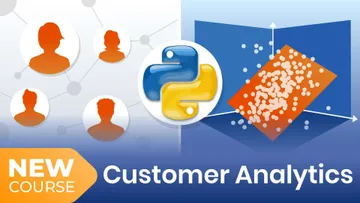Customer churn is the phenomenon in which a client stops doing business with an entity. Users can stop using a company’s product or service for a variety of reasons, such as affordability, dissatisfaction with the offering, and bad customer service.
More often than not, customers who churn from one company will start doing business with their competitor. For instance, if you aren’t happy with your current mobile service provider due to slow Internet speed, you are likely to switch to an alternative.
The act of churning isn’t one that happens suddenly. If you experience low network bandwidth, you are likely to tolerate it for a month or two. During this period, you would probably contact customer support, check your network speed, and leave a review on social media expressing your dissatisfaction.
If the data scientists at your current provider can collect this data and ascertain that your behavior is similar to that of other customers who have churned in the past, they will immediately alert the marketing team, who will then reach out to you and attempt to cater to your needs in the best way possible. They may provide you with special promotions, upgrade your plan, and work on creating a satisfactory user experience for you to prevent you from leaving.
Customer churn prediction is one of the most popular use cases of data science in marketing. Companies incur a lot of costs when users churn since it is expensive to replace an existing customer. Due to this, most mid to large-sized organizations will have some sort of churn prediction mechanism in place.
Offering streamlined experiences, competitive pricing, good service, and strong CRM contact center solutions are crucial for increasing customer retention. But being able to predict churn and address the customers' concerns timely is the key to nurturing loyal clients.
For subscription-based companies like Netflix and Spotify, it is crucial to retain existing customers since the entire business model relies on plan renewals. If you would like to work as a data scientist for companies like these in the future, it is a good idea to learn about techniques such as customer churn prediction.
You can build a churn prediction model and showcase it on your resume, as this is a use case that is relevant to almost every organization and will help your portfolio stand out amongst other data science candidates.
In this article, we will show you how to build a customer churn prediction model in Python using the random forests algorithm.
Table of Contents:
- Prerequisites for Building a Churn Prediction Model
- Reviewing the Dataset
- Exploratory Data Analysis for Customer Churn Prediction
- Preprocessing Data for Customer Churn
- Building the Customer Churn Prediction Model
- Customer Churn Prediction Model Evaluation
- How to Build a Customer Churn Model in Python: Next Steps
Step 1: Pre-Requisites for Building a Churn Prediction Model
We will use the Telco Customer Churn dataset from Kaggle for this analysis. You also need a Python IDE to run the codes provided here, and I suggest using a Jupyter Notebook since the software makes it easy to run code snippets and create visualizations.
If you are new to Python, check out our beginner-friendly tutorial for installing Jupyter.
Finally, make sure to also have the following libraries installed - pandas, Matplotlib, Seaborn, Scikit-Learn, and Imblearn.
Step 2: Reviewing the Dataset
First, let’s load the dataframe into Python with the pandas library and take a look at its head. I’ve renamed the file to “customer_churn.csv”, and it is the name I will be using below:
import pandas as pd
df = pd.read_csv('Customer_Churn.csv')
df.head()

Notice that the dataframe has 21 columns related to telecom user subscription behavior.
Let’s look into these variables further by listing them out:
df.info()
Each user is identified through a unique customer ID. There are 19 independent variables used to predict the target feature – customer churn. In this dataset, customer churn is defined as users who have left within the last month.
Let’s count the number of customers in the dataset who have churned:
df["Churn"].value_counts()
Only around 27% of the customers in the dataset have churned. This means that we are dealing with an imbalanced classification problem. We will need to perform some feature engineering to create a balanced training dataset before building the predictive model.
Step 3: Exploratory Data Analysis for Customer Churn Prediction
Now, let’s perform some exploratory data analysis to gain a better understanding of the independent variables in the dataset and their relationship with customer churn.
We will start by analyzing the demographic data points:
import matplotlib.pyplot as plt
import seaborn as sns
import numpy as np
cols = ['gender','SeniorCitizen',"Partner","Dependents"]
numerical = cols
plt.figure(figsize=(20,4))
for i, col in enumerate(numerical):
ax = plt.subplot(1, len(numerical), i+1)
sns.countplot(x=str(col), data=df)
ax.set_title(f"{col}")
The code above will render the following charts:

Most customers in the dataset are younger individuals without a dependent. There is an equal distribution of user gender and marital status.
Now, let’s look into the relationship between cost and customer churn. In the real world, users tend to unsubscribe to their mobile service provider and switch to a different brand if they find the monthly subscription cost too high. Let’s check if that behavior is reflected in our dataset:
sns.boxplot(x='Churn', y='MonthlyCharges', data=df)
The assumption above is true. Customers who churned have a higher median monthly charge than customers who renewed their subscription.
Finally, let’s analyze the relationship between customer churn and a few other categorical variables captured in the dataset:
cols = ['InternetService',"TechSupport","OnlineBackup","Contract"]
plt.figure(figsize=(14,4))
for i, col in enumerate(cols):
ax = plt.subplot(1, len(cols), i+1)
sns.countplot(x ="Churn", hue = str(col), data = df)
ax.set_title(f"{col}")

Let’s look into each attribute:
- InternetService: It is clear from the visual above that customers who use fiber optic Internet churn more often than other users. This might be because fiber Internet is a more expensive service, or this provider doesn’t have good coverage.
- TechSupport: Many users who churned did not sign up for tech support. This might mean that these customers did not receive any guidance on fixing technical issues and decided to stop using the service.
- OnlineBackup: Many customers who had churned did not sign up for an online backup service for data storage.
- Contract: Users who churned were almost always on a monthly contract. This makes sense, since these customers pay for the service on a monthly basis and can easily cancel their subscription before the next payment cycle.
Even without building a fancy machine learning model, a simple data-driven analysis like this can help organizations understand why they are losing customers and what they can do about it.
For instance, if the company realizes that most of their users who churn have not signed up for tech support, they can include this as a complimentary service in some of their future product offerings to prevent other customers from leaving.
Step 4: Preprocessing Data for Customer Churn
Now that we have a better understanding of our dataset, let’s perform some data preparation before creating the machine learning model. There are three steps to this process:
Cleaning the dataset
Let’s look at the dataset summary again:

Notice that the variable “TotalCharges” has the data type “object,” when it should be a numeric column. Let’s convert this column into a numeric one:
df['TotalCharges'] = df['TotalCharges'].apply(lambda x: pd.to_numeric(x, errors='coerce')).dropna()Encoding Categorical Variables
The categorical variables in the dataset need to be converted into a numeric format before we can feed them into the machine learning model. We will perform the encoding using Scikit-Learn’s label encoder.
First, let’s take a look at the categorical features in the dataset:
cat_features = df.drop(['customerID','TotalCharges','MonthlyCharges','SeniorCitizen','tenure'],axis=1)
cat_features.head()

Now, let’s take a look at the dataset after encoding these categorical variables:
from sklearn import preprocessing
le = preprocessing.LabelEncoder()
df_cat = cat_features.apply(le.fit_transform)
df_cat.head()

Notice that all the categorical values in the dataset have now been replaced with numbers.
Finally, run the following lines of code to merge the dataframe we just created with the previous one:
num_features = df[['customerID','TotalCharges','MonthlyCharges','SeniorCitizen','tenure']]
finaldf = pd.merge(num_features, df_cat, left_index=True, right_index=True)
Oversampling
As mentioned above, the dataset is imbalanced, which means that a majority of values in the target variable belong to a single class. Most customers in the dataset did not churn - only 27% of them did.
This class imbalance problem can lead to an underperforming machine learning model. Some algorithms that train on an imbalanced dataset always end up predicting the majority class. In our case, for instance, the model may predict that none of the customers churned. While a model like this will be highly accurate (in this case it will be correct 73% of the time), it is of no value to us since it is always predicting a single outcome.
There are a variety of techniques that can be used to overcome the class imbalance problem in machine learning. In this tutorial, we will use a technique called oversampling. This is a process that involves randomly selecting samples from the minority class and adding it to the training dataset. We are going to oversample the minority class until the number of data points are equal to that of the majority class.
Before we oversample, let’s do a train-test split. We will oversample solely on the training dataset, as the test dataset must be representative of the true population:
from sklearn.model_selection import train_test_split
finaldf = finaldf.dropna()
finaldf = finaldf.drop(['customerID'],axis=1)
X = finaldf.drop(['Churn'],axis=1)
y = finaldf['Churn']
X_train, X_test, y_train, y_test = train_test_split(X, y, test_size=0.33, random_state=42)
Now, let’s oversample the training dataset:
from imblearn.over_sampling import SMOTE
oversample = SMOTE(k_neighbors=5)
X_smote, y_smote = oversample.fit_resample(X_train, y_train)
X_train, y_train = X_smote, y_smote
Let’s check the number of samples in each class to ensure that they are equal:
y_train.value_counts()There should be 3,452 values in each class, which means that the training dataset is now balanced.
Step 5: Building the Customer Churn Prediction Model
We will now build a random forest classifier to predict customer churn:
from sklearn.ensemble import RandomForestClassifier
rf = RandomForestClassifier(random_state=46)
rf.fit(X_train,y_train)
Step 6: Customer Churn Prediction Model Evaluation
Let’s evaluate the model predictions on the test dataset:
from sklearn.metrics import accuracy_score
preds = rf.predict(X_test)
print(accuracy_score(preds,y_test))
Our model is performing well, with an accuracy of approximately 0.78 on the test dataset.
• Drop or rename columns after training the model
• Use a different set of features during prediction
• Apply inconsistent preprocessing steps to your test data
1. Use the Same Features in the Same Order
Ensure the prediction data uses the exact same column names and order as the training data. Store the list of training features like this:
model_features = X_train.columns
Then, apply it during prediction:
X_test = X_test[model_features]
2. Consistent Preprocessing If you applied scaling, encoding, or imputation during training, make sure to use the same transformers on your test or new input data.
How to Build a Customer Churn Model in Python: Next Steps
If you managed to follow along for the entire tutorial, congratulations! You have now successfully built a customer churn prediction model in Python and are one step closer towards becoming a marketing data scientist.
Most data scientists who work in the industry are skilled in using data to solve business problems. This can either be in the form of a simple analysis like the one we performed above or a more complex predictive model.
To become a data scientist in the field of marketing, it is essential to not only possess technical know-how, but also business acumen. You need to understand how business use-cases can be converted into data science problems, and how data can be used to gain and retain customers.
If all this sounds foreign to you, don’t fret! 365 Data Science offers a course dedicated to Customer Analytics in Python that will teach you how to apply data science techniques in the field of marketing. By taking this course you will master tasks such as predicting user purchase behavior, completing the purchase cycle, and building customer segmentation models. This is a great course for you to gain marketing domain knowledge and hone your data science skills.







